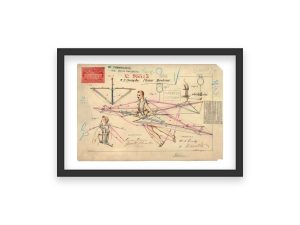W.F. Quinby’s 1869 Flying Machine: A Bold Step Toward the Skies

In 1869, W.F. Quinby patented an ambitious invention—a “Flying Machine” that aimed to let humans soar like birds. His design, filed on October 5, included wings powered by the pilot’s arms and legs, using a system of pulleys and cables. While it never actually flew, this invention shows how early aviation pioneers were determined to make flight a reality, even before engines or modern aerodynamics were understood.
How It Worked
Quinby’s flying machine strapped the pilot into a harness, with levers and cables connected to large wings. By moving their arms and legs, the pilot would flap the wings, similar to how a bird flies. The design also included a tail for steering, showing an impressive understanding of the basics of flight for the time. Did you know that inventors had been sketching flying machines for centuries, starting with Leonardo da Vinci in the 1400s?
Early Flight Challenges
In Quinby’s time, people didn’t yet have lightweight engines or strong materials to make flying possible. Machines like this relied only on human strength, which wasn’t enough to lift a person into the air. Even so, these early attempts inspired later aviation breakthroughs, including the Wright brothers’ first successful flight in 1903.
A Look at the Patent
Quinby’s detailed patent drawings show not just how the machine worked but also the hope and creativity of the era. The pilot is drawn with a confident expression, as if ready to take to the skies. The design’s bright colors and detailed lines make it clear how much thought went into this invention, even if it never worked as intended.
Did You Know?
• The first human-powered flying machines weren’t successful until the 20th century, long after Quinby’s time.
• Early flight inventors faced criticism and ridicule for their ideas, but their persistence paved the way for modern aviation.
W.F. Quinby’s flying machine is a piece of history that reminds us how far we’ve come in aviation. It’s proof that big dreams—no matter how impossible they may seem at first—can inspire real progress.

